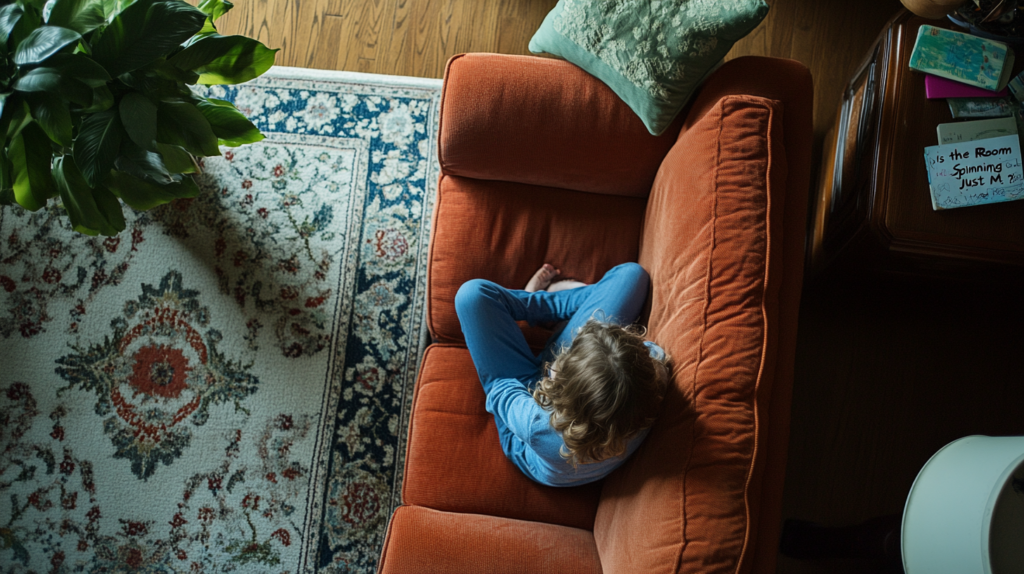Being a mom already feels like balancing on a tightrope while juggling flaming objects. Add vertigo to the mix, and it’s like someone shook the rope, tossed it in a fog machine, and said, “Good luck!” If you’ve ever felt like the world was spinning while you’re just trying to pour a cup of coffee or get your kid’s shoes on, you’re not alone.
Vertigo isn’t just a minor inconvenience—it can hijack your day, drain your energy, and make even the simplest tasks feel impossible. But it doesn’t have to run the show. There are ways to manage it, even when life refuses to slow down.
When “Dizzy” Feels Like an Understatement
Vertigo isn’t just feeling lightheaded. It’s that disorienting sensation where the room tilts, spins, or shifts, even though you’re standing still. It can hit like a sneak attack while you’re loading the dishwasher, lying in bed, or chasing after your toddler who thinks pants are optional. And it’s not just the spinning—you might also feel nauseous, unsteady, or like your brain is wrapped in cotton.
What makes vertigo extra frustrating is how unpredictable it is. One minute, you’re fine. The next, it feels like you’re on a merry-go-round you never signed up for. The triggers vary—sometimes it’s sudden head movements, dehydration, or even stress (which is ironic because nothing says “relax” like worrying about when your next vertigo episode will strike).
The first step in managing it is recognizing patterns. When does it hit hardest? What were you doing right before? Identifying triggers won’t solve everything, but it gives you a roadmap to avoid the worst of it.
Why Sleep (Yes, Sleep) Might Be Making It Worse

Moms are notorious for sacrificing sleep, but if you’re dealing with vertigo, that habit could be making things worse. Sleep isn’t just a luxury—it’s how your brain resets. Poor sleep can mess with your inner ear (which controls balance) and make vertigo episodes more frequent or intense.
It’s not just about getting more sleep—it’s about creating healthier sleep places. Think of your bedroom as a recovery zone, not just a crash pad. Keep it cool, dark, and quiet. Ditch the screens at least 30 minutes before bed (I know, easier said than done). Pay attention to your pillow and mattress, too.
The wrong pillow can mess with neck alignment, which can trigger dizziness for some people. And if you’re someone who wakes up dizzy, try sleeping with your head slightly elevated. Small tweaks can make a big difference.
The Game-Changer You Probably Haven’t Tried
If you’ve been battling vertigo for a while, you’ve probably Googled every possible solution—hydration tips, head exercises, maybe even weird dietary changes. But something you might not have tried yet but will change your life is physical therapy for vertigo. Yes, actual therapy, tailored to your dizziness.
Physical therapists trained in vestibular rehab can teach you exercises that retrain your brain and body to handle the mixed-up signals causing your vertigo. It’s not about general balance exercises or random stretches; it’s targeted, personalized, and surprisingly effective.
The exercises might seem simple—like controlled head movements or balance tasks—but they work because they’re designed to desensitize your brain to the triggers. Some people see improvements in just a few sessions, while others benefit from ongoing support.
The best part? These exercises fit into your life without adding extra chaos. You can do them while your kid watches a show or during nap time. It’s like giving your brain a workout that actually helps you stand up without feeling like the floor is moving.
Mom Hacks for Getting Through the Day Without Falling Over
Let’s be real—no matter how well you manage your vertigo, there will be days when it sneaks up on you. On those days, it’s all about survival mode with a twist of strategy. First, embrace the art of delegation. If your partner, friend, or family member can help—even for 30 minutes—take the help. You’re not failing; you’re being smart.
Next, adjust your environment. Keep things you use often within easy reach to avoid bending or stretching too much. If dizziness hits hard, sit down immediately. Trying to “push through” can lead to falls, and no one has time for an ER visit over stubbornness. Drinking water regularly helps, especially if dehydration triggers your episodes.
When it comes to kid management, lower the bar when you need to. Screen time isn’t the enemy on days when you can’t stand up straight. Create little “activity stations” where your child can play safely while you rest nearby. You’re not being lazy—you’re keeping both of you safe.
What No One Tells You About the Emotional Side of Vertigo
Vertigo isn’t just a physical problem; it messes with your head emotionally, too. The fear of an episode striking at the worst possible moment (like in the middle of a grocery store) can create anxiety that’s just as exhausting as the dizziness itself. It can make you feel isolated, like no one really gets how hard it is to function when your brain feels like it’s short-circuiting.
Talking about it helps. Whether it’s with a therapist, a support group, or a friend who won’t brush it off, sharing your experience lightens the emotional load. It’s also a reminder that you’re not broken—you’re dealing with something real, and it’s okay to ask for support.
Practicing mindfulness techniques, like grounding exercises, can help manage the anxiety that comes with the unpredictability of vertigo. It’s not a cure, but it helps you feel less like you’re at the mercy of your symptoms.
The Bottom Line: You’re Still in Control
Vertigo might make you feel like you’re spinning out of control, but you’re not powerless. From understanding your triggers to finding effective treatments, every small step you take adds up. It’s about managing, not just enduring. You don’t have to accept dizziness as your new normal.
There are tools, strategies, and support that can help you reclaim your balance—literally and figuratively. Even on the tough days, you’re doing more than you realize. And that, in itself, is pretty incredible.
















